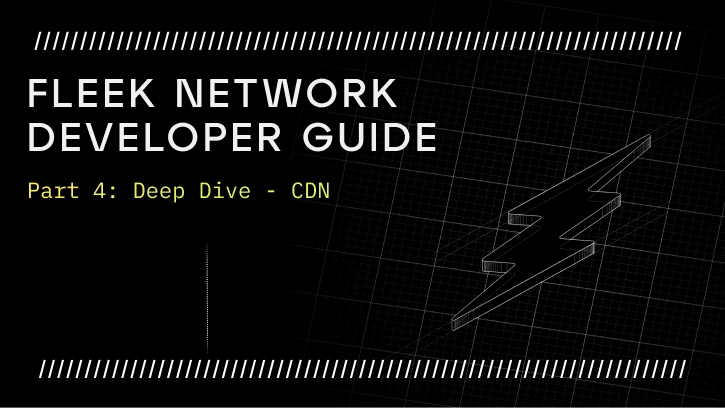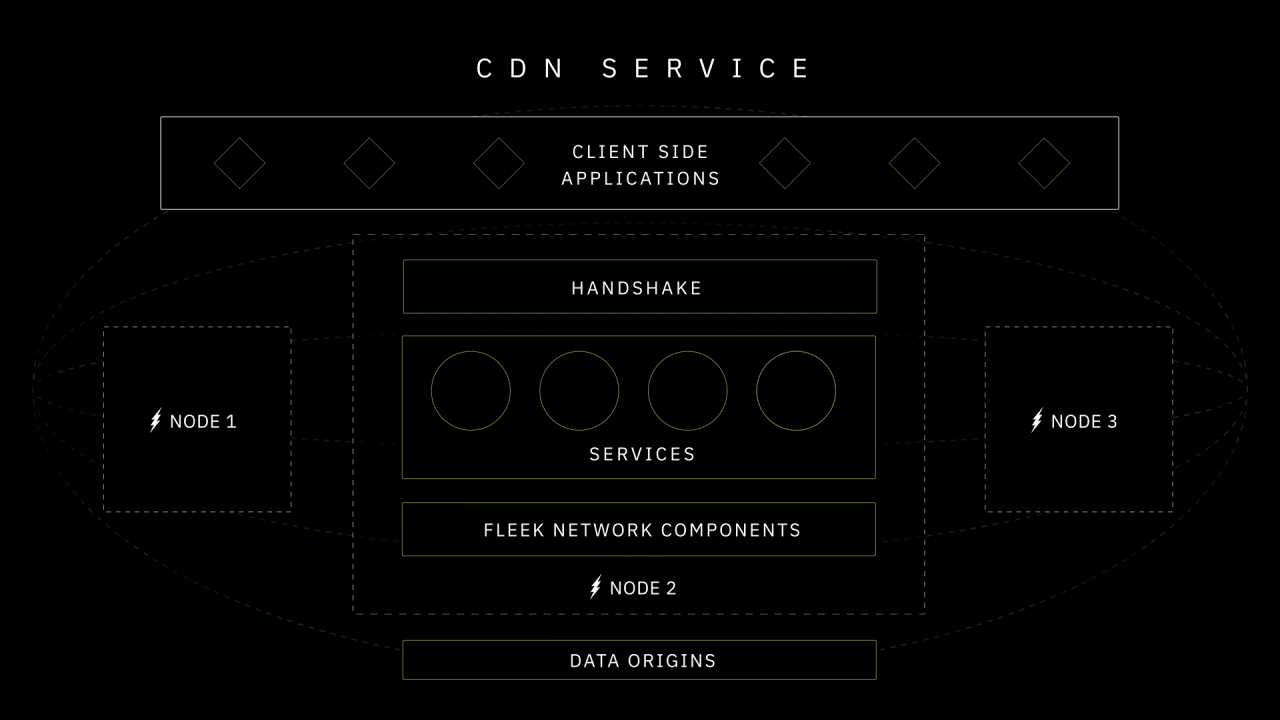Fleek Network Developer Guide Part 4: Service Deep Dive - CDN

Welcome back to the Fleek Network Developer Guide series. Previously, we discussed the JS Runtime Service in depth in Part 3. In Part 4, let’s expand and understand how you will be able to leverage the CDN (Content Delivery Network) Service built on Fleek Network to improve performance of your applications and reduce load times for your end users.
The CDN Service is a critical piece of Fleek Network as it is used by almost every service and use case built on top of the network. It provides performant data delivery for any kind of files or data that a service or app leveraging Fleek Network needs. It is also unique compared to traditional CDNs in that all the bandwidth served is verified, meaning there is real-time cryptographic proof that the files/data being served are in fact the files/data being requested.
Intriguing right? Let’s dive deeper into how the CDN Service works -
CDN Service Overview

The CDN Service on Fleek Network is a foundational service that is used by almost every other service, application and use case leveraging the network (in addition to it just being used as a standalone service). It ensures rapid request-response resolution between any client application that is requesting some data and response from Fleek Network. Fleek nodes cache data being requested, and since the network is geo-aware, the closest node to each client request responds to the client with the appropriate data.
The CDN Service on Fleek Network has the following unique attributes:
Enhanced Global Coverage: Popular existing CDNs like Cloudflare have 310 POP (Points of Presence) Locations. Most others are around that range. By contrast, Fleek Network will have about an order of magnitude greater coverage (~3,000 nodes), potentially higher as network usage grows and warrants more nodes/capacity. This means in a lot of scenarios and geographies, Fleek Network should have a POP closer to the end user making the request, which should result in lower latency and load times.
Intelligent Routing: Fleek Network intelligently routes each client request to the lowest latency/highest reputation node available in the geographic vicinity of the request, to ensure the user always gets a fast/geo-optimized response. This is all handled automatically by the network and every app/use case leveraging the CDN gets these same routing benefits out of the box.
Content Addressing: Fleek Network uses Blake3 hashing for efficient content identification and streaming verifiability, as well as a DHT (Distributed Hash Table) that enables the network to store a flexible mapping from any "immutable data pointer" to its corresponding Blake3 hash. Not only does this provide automatic deduplication of data leading to greater network efficiency and performance, it’s also what enables better censorship resistance guarantees for every app/use case leveraging the CDN.
Origin Agnostic: Fleek Network can fetch and cache data from any data origin to be consumed by various services and served to client applications. This brings significant flexibility and composability to the network, by essentially allowing developers to use the CDN Service in conjunction with any other infrastructure or software (web2 or web3) to augment performance.
Verified Bandwidth: Thanks to the Blake3 hashing and another key aspect of Fleek Network called Delivery Acknowledgements (outside the scope of this blog but will be covered in a separate one), all bandwidth is streamed and cryptographically verified in real-time, meaning all applications and use cases leveraging the Fleek CDN Service can be 100% certain that all data/files being served each request are in fact the data/files being requested.
CDN Service Benefits
The above unique attributes of Fleek Network that the CDN Service inherits result in the following benefits for all applications and use cases leveraging the CDN Service:
Super Low Latency: Thanks to the enhanced global coverage and intelligent routing, Fleek Network is able to provide high performance and ultra-low latency, which leads to better UX and happier end users for every app and use case leveraging the CDN.
Competitive Costs: Fleek Network leverages intelligent routing and other network capabilities (P2P, Multicast, etc.) to not only optimize for performance but also cost. Future enhancements to the CDN will also include additional routing logic at the ISP, Data Center, and Network level to unlock further performance and cost efficiencies (following similar lines of thinking to how Netflix Open Connect does it).
High Reliability: Due to the decentralized nature of Fleek Network, there are no central points of failure by design. With thousands of different nodes and operators powering the network, the resilience and uptime of the network we anticipate to be extremely high, with a realistic possibility of exceeding web2 reliability and uptime. However right now this is just a claim, we need to follow up with data to substantiate this claim once the network has been fully up and running for a bit.
Better DDOS Protection: Thanks to the greater global coverage and higher POP/node count compared to traditional CDNs, Fleek Network is extremely well positioned to handle things like DDOS attacks, given the high number of unique IP addresses the network can use to absorb and distribute the traffic across.
No Corporate Nonsense: Given the decentralized, permissionless, and transparent nature of Fleek Network, you don’t need to worry about the typical corporate cloud platform/CDN woes (pricing changes, data abuse, censorship, lack of transparency, de-platforming, etc.).
CDN Service Use Cases
Now that we understand some of the unique attributes and benefits of Fleek Network’s CDN Service, let’s look at some of the best use cases and ways you can leverage the CDN Service:
Standalone CDN: The simplest way to use the CDN Service is simply to use it as a CDN. Almost every web application in existence today uses a CDN; CDNs serve the majority of internet traffic. But for example, even if you just look at the web3 space, almost every protocol, middleware, and app in the web3 space today uses Cloudflare (or another traditional CDN). A lot of them are looking for a performant decentralized alternative. Fleek Network’s CDN Service is exactly that.
Building Block for Other Services/Use Cases: The CDN Service on Fleek Network is a foundational service that every other service or use case on the network can leverage. For example, the static and Next.js hosting use cases both leverage the CDN Service. Many other use cases will do the same.
Media Streaming: Fleek Network is uniquely positioned to offer highly performant video/media streaming due to the reduced distance between nodes and clients, as well as the transport layer agnostic nature of the network.
Verified Bandwidth as a New Primitive: There are a lot of very cool things that can be built with this new verified bandwidth primitive. Especially in the context of web3 and the communication between different protocols and layers of the stack.
These are just some low hanging fruit use cases of the CDN Service on Fleek Network, but there are tons of other possibilities we encourage developers to explore and ideate on.
With this, we come to the end of Fleek Network Developer Guide Part 4! We will be back next week with another installment.
If you missed it, check out Part 2 and Part 3 of the Developer Guide where we understood Fleek Network Services in-depth and also dove deep into the JS Runtime Service. Also, feel free to check out the Whitepaper or GitHub if you want to dive deeper into the tech.
Follow along here on X for the latest on Fleek Network’s rollout ⚡
-Fleek Foundation